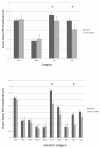The late positive potential (LPP) in response to varying types of emotional and cigarette stimuli in smokers: a content comparison
- PMID: 23643564
- PMCID: PMC3771859
- DOI: 10.1016/j.ijpsycho.2013.04.019
The late positive potential (LPP) in response to varying types of emotional and cigarette stimuli in smokers: a content comparison
Abstract
Identifying neural mechanisms associated with addiction has substantially improved the overall understanding of addictive processes. Indeed, research suggests that drug-associated cues may take advantage of neural mechanisms originally intended for emotional processing of stimuli relevant to survival. In this study, we investigated cortical responses to several categories of emotional cues (erotic, romance, pleasant objects, mutilation, sadness, and unpleasant objects) as well as two types of smoking-related cues (people smoking and cigarette-related objects). We recorded ERPs from 180 smokers prior to their participation in a smoking cessation clinical trial and assessed emotional salience by measuring the amplitude of the late positive potential (LPP; 400 to 600 ms after picture onset). As expected, emotional and cigarette-related pictures prompted a significantly larger LPP than neutral pictures. The amplitude of the LPP increased as a function of picture arousal level, with high-arousing erotic and mutilation pictures showing the largest response in contrast to low-arousing pleasant and unpleasant objects, which showed the smallest response (other than neutral). Compared to females, male participants showed larger LPPs for high-arousing erotic and mutilation pictures. However, unlike emotional pictures, no difference was noted for the LPP between cigarette stimuli containing people versus those containing only objects, suggesting that in contrast to emotional objects, cigarette-related objects are highly relevant for smokers. We also compared the smokers to a small (N=40), convenience sample of never-smokers. We found that never-smokers had significantly smaller LPPs in response to erotic and cigarette stimuli containing only objects compared to smokers.
Keywords: ERP; Emotion; Event related potentials; LPP; Nicotine dependence; Smoking.
Copyright © 2013 Elsevier B.V. All rights reserved.
Figures



Similar articles
-
The Late Positive Potentials Evoked by Cigarette-Related and Emotional Images Show no Gender Differences in Smokers.Sci Rep. 2019 Mar 1;9(1):3240. doi: 10.1038/s41598-019-39954-0. Sci Rep. 2019. PMID: 30824792 Free PMC article.
-
Brain reactivity to emotional, neutral and cigarette-related stimuli in smokers.Addict Biol. 2011 Apr;16(2):296-307. doi: 10.1111/j.1369-1600.2010.00273.x. Epub 2010 Dec 23. Addict Biol. 2011. PMID: 21182573 Free PMC article.
-
Individual differences in brain responses to cigarette-related cues and pleasant stimuli in young smokers.Drug Alcohol Depend. 2016 Jun 1;163:229-35. doi: 10.1016/j.drugalcdep.2016.04.025. Epub 2016 Apr 25. Drug Alcohol Depend. 2016. PMID: 27141838 Free PMC article. Clinical Trial.
-
Affective picture processing: an integrative review of ERP findings.Biol Psychol. 2008 Mar;77(3):247-65. doi: 10.1016/j.biopsycho.2007.11.006. Epub 2007 Nov 17. Biol Psychol. 2008. PMID: 18164800 Free PMC article. Review.
-
The P300, the LPP, context updating, and memory: What is the functional significance of the emotion-related late positive potential?Int J Psychophysiol. 2023 Oct;192:43-52. doi: 10.1016/j.ijpsycho.2023.08.005. Epub 2023 Aug 14. Int J Psychophysiol. 2023. PMID: 37586592 Free PMC article. Review.
Cited by
-
Smokers exhibit biased neural processing of smoking and affective images.Health Psychol. 2016 Aug;35(8):866-9. doi: 10.1037/hea0000350. Health Psychol. 2016. PMID: 27505209 Free PMC article.
-
Acute sensitization of the P3 event-related potential response to beverage images and the risk for alcohol use disorder.Addict Neurosci. 2022 Dec;4:100041. doi: 10.1016/j.addicn.2022.100041. Epub 2022 Oct 28. Addict Neurosci. 2022. PMID: 36425356 Free PMC article.
-
The controllability of aversive and neutral pictures: an event-related potential study.Behav Brain Res. 2021 Jun 25;408:113265. doi: 10.1016/j.bbr.2021.113265. Epub 2021 Mar 29. Behav Brain Res. 2021. PMID: 33794224 Free PMC article.
-
How Is the Neural Response to the Design of Experience Goods Related to Personalized Preference? An Implicit View.Front Neurosci. 2018 Oct 26;12:760. doi: 10.3389/fnins.2018.00760. eCollection 2018. Front Neurosci. 2018. PMID: 30416423 Free PMC article.
-
Electrophysiological Markers of Fairness and Selfishness Revealed by a Combination of Dictator and Ultimatum Games.Front Syst Neurosci. 2022 May 9;16:765720. doi: 10.3389/fnsys.2022.765720. eCollection 2022. Front Syst Neurosci. 2022. PMID: 35615426 Free PMC article.
References
-
- Borrelli B, Niaura R, Keuthen NJ, Goldstein MG, DePue JD, Murphy C, et al. Development of major depressive disorder during smoking-cessation treatment. Journal of Clinical Psychiatry. 1996;57:534–538. - PubMed
-
- Bradley MM, Codispoti M, Sabatinelli D, Lang PJ. Emotion and motivation II: sex differences in picture processing. Emotion. 2001;1:300–319. - PubMed
-
- Briggs KE, Martin FH. Affective picture processing and motivational relevance: arousal and valence effects on ERPs in an oddball task. Int.J Psychophysiol. 2009;72:299–306. - PubMed
Publication types
MeSH terms
Grants and funding
LinkOut - more resources
Full Text Sources
Other Literature Sources
Medical
Research Materials

